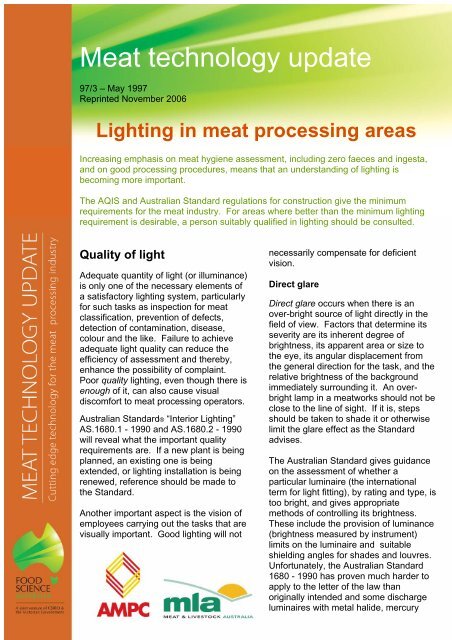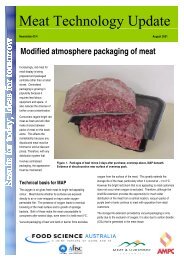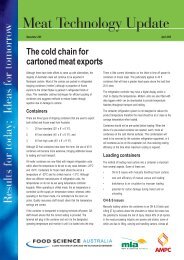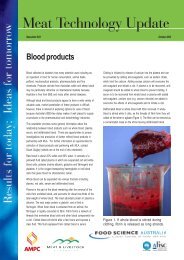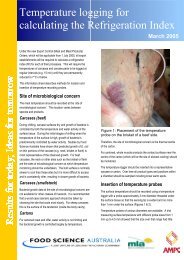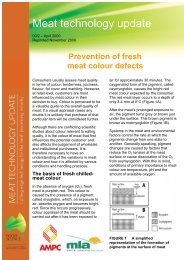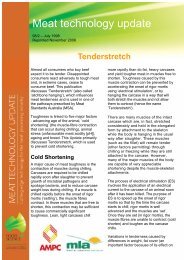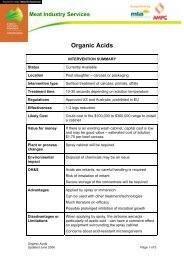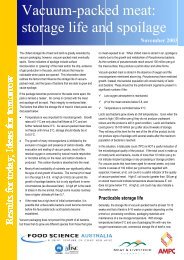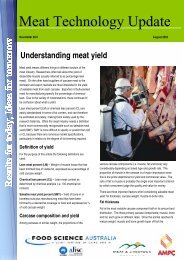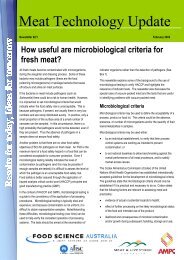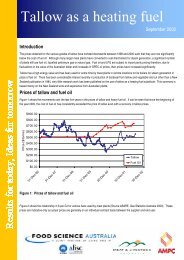Lighting in meat processing areas May 1997 - Red Meat Innovation
Lighting in meat processing areas May 1997 - Red Meat Innovation
Lighting in meat processing areas May 1997 - Red Meat Innovation
You also want an ePaper? Increase the reach of your titles
YUMPU automatically turns print PDFs into web optimized ePapers that Google loves.
<strong>Meat</strong> technology update97/3 – <strong>May</strong> <strong>1997</strong>Repr<strong>in</strong>ted November 2006<strong>Light<strong>in</strong>g</strong> <strong>in</strong> <strong>meat</strong> process<strong>in</strong>g <strong>areas</strong>Increas<strong>in</strong>g emphasis on <strong>meat</strong> hygiene assessment, <strong>in</strong>clud<strong>in</strong>g zero faeces and <strong>in</strong>gesta,and on good process<strong>in</strong>g procedures, means that an understand<strong>in</strong>g of light<strong>in</strong>g isbecom<strong>in</strong>g more important.The AQIS and Australian Standard regulations for construction give the m<strong>in</strong>imumrequirements for the <strong>meat</strong> <strong>in</strong>dustry. For <strong>areas</strong> where better than the m<strong>in</strong>imum light<strong>in</strong>grequirement is desirable, a person suitably qualified <strong>in</strong> light<strong>in</strong>g should be consulted.Quality of lightAdequate quantity of light (or illum<strong>in</strong>ance)is only one of the necessary elements ofa satisfactory light<strong>in</strong>g system, particularlyfor such tasks as <strong>in</strong>spection for <strong>meat</strong>classification, prevention of defects,detection of contam<strong>in</strong>ation, disease,colour and the like. Failure to achieveadequate light quality can reduce theefficiency of assessment and thereby,enhance the possibility of compla<strong>in</strong>t.Poor quality light<strong>in</strong>g, even though there isenough of it, can also cause visualdiscomfort to <strong>meat</strong> process<strong>in</strong>g operators.Australian Standard® “Interior <strong>Light<strong>in</strong>g</strong>”AS.1680.1 - 1990 and AS.1680.2 - 1990will reveal what the important qualityrequirements are. If a new plant is be<strong>in</strong>gplanned, an exist<strong>in</strong>g one is be<strong>in</strong>gextended, or light<strong>in</strong>g <strong>in</strong>stallation is be<strong>in</strong>grenewed, reference should be made tothe Standard.Another important aspect is the vision ofemployees carry<strong>in</strong>g out the tasks that arevisually important. Good light<strong>in</strong>g will notnecessarily compensate for deficientvision.Direct glareDirect glare occurs when there is anover-bright source of light directly <strong>in</strong> thefield of view. Factors that determ<strong>in</strong>e itsseverity are its <strong>in</strong>herent degree ofbrightness, its apparent area or size tothe eye, its angular displacement fromthe general direction for the task, and therelative brightness of the backgroundimmediately surround<strong>in</strong>g it. An overbrightlamp <strong>in</strong> a <strong>meat</strong>works should not beclose to the l<strong>in</strong>e of sight. If it is, stepsshould be taken to shade it or otherwiselimit the glare effect as the Standardadvises.The Australian Standard gives guidanceon the assessment of whether aparticular lum<strong>in</strong>aire (the <strong>in</strong>ternationalterm for light fitt<strong>in</strong>g), by rat<strong>in</strong>g and type, istoo bright, and gives appropriatemethods of controll<strong>in</strong>g its brightness.These <strong>in</strong>clude the provision of lum<strong>in</strong>ance(brightness measured by <strong>in</strong>strument)limits on the lum<strong>in</strong>aire and suitableshield<strong>in</strong>g angles for shades and louvres.Unfortunately, the Australian Standard1680 - 1990 has proven much harder toapply to the letter of the law thanorig<strong>in</strong>ally <strong>in</strong>tended and some dischargelum<strong>in</strong>aires with metal halide, mercury
vapour and high pressure sodium lamps, i.e.light sources of sufficient power toeconomically illum<strong>in</strong>ate large process<strong>in</strong>g<strong>areas</strong>, may have difficulty meet<strong>in</strong>g glare testcriteria.Reflected glareIn a survey, lum<strong>in</strong>aires were seen <strong>in</strong>positions where possible troublesomereflections were directed to operators’ eyesfrom wet surfaces of offal on the visceraconveyor, from polished sta<strong>in</strong>less steelwork<strong>in</strong>g surfaces, or from glossy wall tilesand even water lay<strong>in</strong>g on the floor. TheStandard gives guidance on the ways ofelim<strong>in</strong>at<strong>in</strong>g or m<strong>in</strong>imis<strong>in</strong>g such effects. Inmany cases the solution is once aga<strong>in</strong> apractical one such as use of a matt surface<strong>in</strong>stead of a highly polished or glossy one or,m<strong>in</strong>or relocation of lum<strong>in</strong>aires, addition of adiffus<strong>in</strong>g refractor or visor, or simply, use ofcoated or diffuse lamps.Brightness distributionBrightness distribution (the pattern ofbrightness that appears <strong>in</strong> the field of vision)is an important factor for visual efficiencywhen undertak<strong>in</strong>g demand<strong>in</strong>g tasks <strong>in</strong>locations such as the bon<strong>in</strong>g room and theslaughter l<strong>in</strong>e.It is important that the brightness of theobject exam<strong>in</strong>ed (the lum<strong>in</strong>ance) is greaterthan the rema<strong>in</strong>der of the field of view. Thebackground should present a comfortablebrightness distribution. However, if thedifference <strong>in</strong> lum<strong>in</strong>ance between the objectexam<strong>in</strong>ed and the immediate background istoo great (i.e. greater than about four to one),the worker could have problems of adjust<strong>in</strong>gback and forth between the two light levels,thus affect<strong>in</strong>g visual performance.Uniformity of illum<strong>in</strong>ationUniformity refers to the variation <strong>in</strong>illum<strong>in</strong>ance (level read directly by a lightmeter <strong>in</strong> lux) which appears over worksurfaces, and the total work space, e.g. the‘pool<strong>in</strong>g’ pattern created by the spac<strong>in</strong>g oflight fitt<strong>in</strong>gs. Aga<strong>in</strong>, this can contribute toeye stra<strong>in</strong>. Closer spac<strong>in</strong>g of lum<strong>in</strong>aires canimprove uniformity. Lum<strong>in</strong>airemanufacturers provide guidel<strong>in</strong>es for spac<strong>in</strong>gto mount<strong>in</strong>g height ratios.For example, as well as the concentrateddirectional light on the slic<strong>in</strong>g and <strong>in</strong>spectionoperations of the bon<strong>in</strong>g room, it is importantto have an adequate level of generalillum<strong>in</strong>ation (illum<strong>in</strong>ance), mak<strong>in</strong>g ceil<strong>in</strong>gsand walls comfortably bright for those whoglance up from task <strong>areas</strong> of high brightness.ColourThe employees’ reactions to theirsurround<strong>in</strong>gs - how they feel when work<strong>in</strong>g <strong>in</strong>an area - can be very important <strong>in</strong>ma<strong>in</strong>ta<strong>in</strong><strong>in</strong>g productivity. Colour, as already<strong>in</strong>dicated, plays an important part <strong>in</strong> creat<strong>in</strong>ga good work<strong>in</strong>g environment and <strong>in</strong>contribut<strong>in</strong>g to the quality of the light<strong>in</strong>g.Apart from the f<strong>in</strong>ish on work surfaces,ceil<strong>in</strong>g and walls, the correct choice of lampscan contribute <strong>in</strong> this regard.Consideration of two light sourcecharacteristics - colour temperature andcolour render<strong>in</strong>g - will provide someassistance <strong>in</strong> the achievement of optimum<strong>in</strong>terior colour appearance of objects andsurfaces. They are important criteria <strong>in</strong> theselection of the most appropriate source forthe particular visual requirements of the task.Colour temperatureColour temperature is a figure that givesa measure of the colour appearance ofthe light from the lamp itself.The colour appearance of near white lightsources is normally expressed <strong>in</strong> DegreesKelv<strong>in</strong> (K). The higher the figure, the coolerthe appearance of the source; the reddishyellowflame of a candle is about 1900K, theord<strong>in</strong>ary <strong>in</strong>candescent lamp, about 2800K,and cold bluish-white southern sky daylight,over 6500K. Thus the colour of lightchanges from hav<strong>in</strong>g ma<strong>in</strong>ly red/yellowcomponents at about 2500K to light hav<strong>in</strong>gma<strong>in</strong>ly blue components at about 6500K,which approximates natural daylight with ablue sky.2
Lamps with colour temperatures <strong>in</strong> the range3500K to 5000K are generally preferred forcommercial and <strong>in</strong>dustrial applications, thehigher colour temperature lamps be<strong>in</strong>g usedwhere a lively/cool environment is required.Colour temperatures <strong>in</strong> the region of 4300Kare most suitable for tasks <strong>in</strong> abattoirs,especially where visual efficiency is critical,e.g. <strong>in</strong>spection. These lamps may be called‘white’ or ‘cool white’. Higher colourtemperatures may be called ‘daylight’. Thecolour temperature of ‘warm white’ lamps(below 3500K) is generally considered to besuited to comfortable/warm environments(residences) and does not suit the criticalvisual tasks <strong>in</strong> process<strong>in</strong>g <strong>areas</strong>.Colour temperature does not affectillum<strong>in</strong>ation. However, many people willperceive an identical illum<strong>in</strong>ation level undera low colour temperature lamp, e.g. highpressure sodium, as be<strong>in</strong>g much lower thanthat provided by the high colour temperaturelamp, e.g. metal halide. Also, <strong>in</strong> a warmclimate, a low colour temperature lamp cancreate a feel<strong>in</strong>g of warmth. At <strong>in</strong>spectionpo<strong>in</strong>ts a colour temperature of 4000K-5000Kis recommended, provided that the lamp hassuitable colour render<strong>in</strong>g properties.Colour Render<strong>in</strong>gColour render<strong>in</strong>g is the ability of a lightsource to reproduce colours of objectsaccurately, e.g. the <strong>meat</strong> and fat colour, orcontam<strong>in</strong>ants on a carcase. To determ<strong>in</strong>ethe colour render<strong>in</strong>g <strong>in</strong>dex (CRI), a series oftests is conducted with the light source <strong>in</strong>question compared with reference sources oflight with known or calibrated colourrender<strong>in</strong>g properties. This is determ<strong>in</strong>edover a set of eight standard colours. TheCRI is, <strong>in</strong> fact, an average colour render<strong>in</strong>g.Lamps with identical CRI values of 85 fromtwo different manufacturers may, <strong>in</strong> fact,have widely differ<strong>in</strong>g spectral distributions <strong>in</strong>spite of the common CRI value of 85, i.e. onemake might have a high CRI <strong>in</strong> the red bandand a low CRI <strong>in</strong> the blue band, and theother make vice versa.Field tests are necessary to determ<strong>in</strong>e if thelamps are suitable for specific tasks. Aweakness <strong>in</strong> one lamp <strong>in</strong> a particular colourband may be a strength <strong>in</strong> the other lamp.We must remember that an average is a‘mean’ and very high results <strong>in</strong>, for example,six out of the eight tests may give the lamp avery high CRI and yet the colour band mostimportant to your visual task may fall <strong>in</strong>to thepoor area of colour rendition.Lamps which are highly efficient for colourrender<strong>in</strong>g (say, CRI equal to or greater than90), by comparison, often have lowerefficacy, i.e. are lower <strong>in</strong> lumen or lightoutput. As an example, a typical coatedmetal halide lamp with a CRI of 65 has anoutput of 38,000 lumens; a lamp with a CRIof 80 produced by the same manufacturerhas an output of 24,500 lumens.That is to say, a lamp that is necessary toensure that defects and diseases aredetected as a result of faithful colourrender<strong>in</strong>g of these elements to the <strong>in</strong>spectorwill be more costly to purchase and runbecause for a given light output (lumens) itconsumes more power.General production <strong>areas</strong> could beillum<strong>in</strong>ated by lamps with a reasonablecolour rendition ability and with high lumenoutput (efficacy), whereas <strong>areas</strong> with verystr<strong>in</strong>gent <strong>in</strong>spection needs could be locallyillum<strong>in</strong>ated by lamps with a very high CRI orcolour render<strong>in</strong>g ability. This is much easierif the colour-sensitive tasks are isolated <strong>in</strong>separate rooms or sections of the build<strong>in</strong>g.Quantity of light (illum<strong>in</strong>ance)This Update has made reference tolum<strong>in</strong>ance (brightness measured with an<strong>in</strong>strument). Unfortunately, lum<strong>in</strong>ancecannot be measured with a normal lightmeter as the latter measures the amount oflight fall<strong>in</strong>g on a surface (illum<strong>in</strong>ancemeasured as lux). A lum<strong>in</strong>ance metermeasures the brightness of an object as itappears <strong>in</strong> the field of view (reflected light).It is similar to a photographic exposurephotometer used to measure reflected light;however, the lum<strong>in</strong>ance meter is calibrated<strong>in</strong> candelas per square metre. Thelum<strong>in</strong>ance meter would measure ‘brightnessdistribution’ or difference.3
The accurate field measurement ofthe lum<strong>in</strong>ance of exist<strong>in</strong>g lum<strong>in</strong>aires or<strong>in</strong>terior surfaces is generally notpractical. It requires a very expensivelaboratory-type <strong>in</strong>strument. It is farmore appropriate to do this workbefore the <strong>in</strong>stallation is complete.It is important to remember thatillum<strong>in</strong>ance read<strong>in</strong>gs, taken with alight meter, should be taken <strong>in</strong> theplane (horizontal, vertical or <strong>in</strong>cl<strong>in</strong>ed)of the object be<strong>in</strong>g exam<strong>in</strong>ed, asviewed by the operator and as closeto the object as practicable. Hence, alight meter read<strong>in</strong>g on a <strong>meat</strong> carcasehang<strong>in</strong>g on the slaughter l<strong>in</strong>e shouldbe taken with the meter ly<strong>in</strong>g <strong>in</strong> thevertical plane of the carcase, becauseit is the illum<strong>in</strong>ance on the verticalsides of <strong>meat</strong> as seen by theoperators that determ<strong>in</strong>es visibility.representative average illum<strong>in</strong>ancevalue, and allow assessment of theuniformity.Ma<strong>in</strong>tenanceMa<strong>in</strong>tenance of light<strong>in</strong>g systemskeeps the performance of the systemwith<strong>in</strong> the design limits, promotessafety, and, if considered at thedesign stage, can help to m<strong>in</strong>imise theelectrical load and capital costs.<strong>Light<strong>in</strong>g</strong> systems deteriorate withoutregular ma<strong>in</strong>tenance. The output ofthe lamp decreases as the length oftime it has been <strong>in</strong> operation<strong>in</strong>creases. Different lamp typesdeteriorate at different rates.Further, dirt deposition will occur onlamps, lum<strong>in</strong>aires and other surfaces.Unfortunately, most of the <strong>meat</strong><strong>in</strong>dustry regulations refer toillum<strong>in</strong>ance values (lux) on a planeone metre above the floor or on animag<strong>in</strong>ary horizontal work plane,which is often not where the operatoris view<strong>in</strong>g the task. Us<strong>in</strong>g computertechnology, the light<strong>in</strong>g eng<strong>in</strong>eer cancomply with this requirement, yet doadditional vertical or slope planeillum<strong>in</strong>ance calculation checks todeterm<strong>in</strong>e if the illum<strong>in</strong>ance <strong>in</strong> theseplanes is of sufficient quantity anduniformity.A sufficient number of illum<strong>in</strong>ancemeasurements should be made overthe task area to provide aContact us for additional <strong>in</strong>formation<strong>Meat</strong> Industry Services is supported by the Australian <strong>Meat</strong> Processor Corporation (AMPC) and <strong>Meat</strong> & Livestock Australia (MLA).Brisbane: Sydney: Adelaide:Food Science Australia Bill Spooncer Chris SentancePO Box 3312 PO Box 181 PO Box 178T<strong>in</strong>galpa DC QLD 4173 KURMOND NSW 2757 FLAGSTAFF HILL SA 5159Ian Eustace Neil McPhail Alison SmallT +61 7 3214 2117 T +61 7 3214 211 T +61 7 3214 2109 T +61 2 4567 7952 T +61 8 370 7466F +61 7 3214 2103 F +61 7 3214 2103 F +61 7 3214 2103 F +61 2 4567 8952 F +61 8 8370 7566M 0414 336 724 M 0414 336 907 M 0409 819 998 M 0414 648 387 M 0419 944 022


